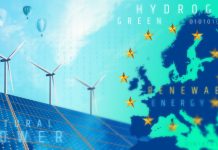Mauro Petriccione, Directorate-General for Climate Action at the European Commission, illustrates Europe’s plans for a green recovery following the COVID-19 pandemic
Humankind stands at a pivotal moment in its history. On top of the immeasurable human tragedy of 2020, the ongoing global health crisis has brought with it huge economic repercussions, the full force of which we are yet to feel. How we choose to bounce back from this crisis will dictate our future on this planet. But there is reason for hope in spite of the economic pressures.
The impact of COVID-19
The pandemic has shown how vulnerable we are to nature’s forces, and while climate change may act slower than a virus, it will prove equally deadly. This we know already from the victims of increasingly severe weather events and of the economic disruption, which also accompanies climate change. Science tells us that we must stop global warming shortly after mid-century, and reverse it thereafter — stop the growth in greenhouse gas emissions, achieve a balance, and remove them from our atmosphere. In Europe, we have called this “climate neutrality.” We want to achieve this by 2050 at the latest, and the first step will be to strike a path out of the current crisis by leading a global green transition.
This goal will be a huge undertaking, but it does not have to mean economic sacrifice. The EU has a proven record of achieving economic growth while reducing greenhouse gas (GHG) emissions. Between 1990 and 2019, EU economies reduced their net GHG emissions by a quarter, while still growing their combined GDP by over 60%. Today, the EU and its Member States have all the laws and the measures in place to achieve our current target of reducing greenhouse gas emissions by at least 40% by 2030, and in fact overshoot it. Yet, this is not enough. At the rate of change that these laws would bring, Europe would have to accelerate its efforts even further after 2030, potentially curbing economic growth.
The European Green Deal
This is why our European Green Deal commits us to making our 2050 pledge legally binding in the EU Climate Law, and the Commission has proposed an ambitious climate target plan for 2030 to reduce net GHG emissions by at least 55%. Our impact assessment shows that this is achievable and beneficial for Europe. It gives industry adequate time to adapt, benefit from first-mover advantage, and avoid carbon lock-in while stemming the continued damage to the climate that further delay would bring.
At the same time, the huge investment that these goals require is just what Europe needs right now to overcome the economic crisis brought about by the COVID- 19 pandemic. In the longer term, front-loading this investment will drive Europe’s longer-term project of a modern, competitive, prosperous and climate-neutral economy and society in 2050, in which no one is left behind.
Much of this investment will come from the private sector, but public funds are required to support much-needed innovation in clean technologies; to ensure solidarity with all those who are less able to manage the transition on their own, and to help citizens and administrations adapt to the disruption that climate change will continue to bring before we can win this fight. The EU is already taking the steps to secure the financial means. The European Parliament and Member States reached agreement on an improved EU budget for 2021-2027 and on an extraordinary recovery instrument, NextGenerationEU. This package of more than €1.8 trillion would enable the EU to tackle both today’s crisis and tomorrow’s challenges. Across the board, 30% of EU funds will be dedicated to fighting climate change.
The twin transitions
In particular, the twin green and digital transitions will be at the heart of the €672.5 billion of new grants and loans from NextGenerationEU’s Recovery and Resilience Facility. Member States will invest 37% of this in climate action projects to stimulate green job creation and sustainable economic growth. These funds will finance clean technologies such as hydrogen, boost the share of renewables in the energy mix, improve the energy efficiency of buildings supporting the Renovation Wave, and accelerate the rollout of sustainable green transport and infrastructure. The Just Transition Mechanism will mobilise over €100 billion of public and private investment to support those regions most vulnerable to potential negative socio-economic impacts of the transition.
The EU will also revise its entire climate and energy framework to put in place the laws and measures we need to match our ambitions. Public consultations on revising the EU Emissions Trading System Directive, the Effort Sharing Regulation, the Land Use, Land Use Change and Forestry Regulation (LULUCF) and the Regulation governing carbon dioxide standards for light-duty vehicles were launched in November 2020, with a view to proposing a full legislative package by June 2021.
The EU will look at how carbon pricing, under the Emissions Trading System, currently covering power and industry, could extend to other parts of the economy; and at how to strengthen the capacity of Europe’s land and forests to sequester carbon from the atmosphere. This will include planting trees, better, more efficient farming practices, rewetting wetlands and promoting greater use of wood products in construction and other sectors. Higher CO2 emissions standards are to be set for the cars and vans on European roads.
Yet, we know our good intentions for a green recovery in Europe will not suffice if we fail to convince others to join us. Not only must we in Europe press ahead with our own ambitious plans for a green transition, but bring international partners on board too. Already, the ranks of the “net-zero club” are growing. Japan has followed the EU and has adopted the 2050 climate neutrality goal, and others aim to achieve at least net- zero CO2 emissions by 2050 (South Africa and South Korea) or 2060 (China). Canada announced a new law on climate neutrality and President-elect Biden has indicated that the U.S. will move in the same direction. There is finally a sense of a global momentum emerging, towards keeping the promise of the Paris Agreement and securing our future on this planet.











